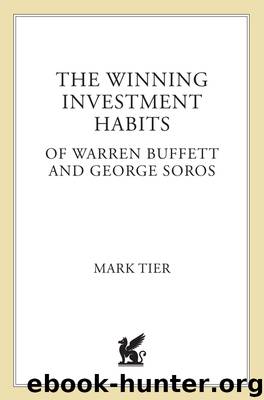The Winning Investment Habits of Warren Buffett & George Soros by Mark Tier

Author:Mark Tier
Language: eng
Format: epub
Publisher: St. Martin's Press
* * *
The Master Investor’s Mistakes
A Master Investor’s errors usually fall into one or more of six categories:
1. He (unwittingly) didn’t follow his system.
2. An oversight: He overlooked something when he made the investment.
3. An emotional blind spot impaired his judgment.
4. He has changed in some way that he hasn’t yet recognized.
5. Something in the environment has changed that he hasn’t noticed.
6. Sins of omission … investments he should have made but didn’t.
* * *
But Studebaker went through the roof. And to make things worse, the spread widened as the “A” shares lagged behind.
Complicating Soros’s predicament, “I had borrowed money from my brother and I was in danger of being entirely wiped out.”6 It was money his brother—who was just starting his own business at the time—could ill afford to lose.
When the trade went against him, Soros didn’t beat a hasty retreat, but hung on, even putting up more margin money to keep his short position open. He was overextended; he hadn’t prepared an exit strategy to follow automatically if the trade went against him. He wasn’t ready for the contingency that he might be wrong.
After a prolonged period during which matters remained touch and go, Soros recouped his money, but the emotional impact of the ordeal was long lasting. “Psychologically it was very important.”7
This was his first major financial setback, and it caused him to rethink his entire approach to the markets. It’s certainly possible to trace many of the components of the investment system that turned Soros into a Master Investor to all the mistakes he made in this particular trade.
Buffett Takes Control
By taking control of Dempster in 1961, Buffett was clearly beginning to move away from the pure Graham system he had been following till then. The businessman inside him was seeking an outlet. But in buying a “cigar butt” like Dempster, he was doing it in a Graham-like fashion.
When he went for his next target, Berkshire Hathaway, he had clearly learned from his experience.
By 1963, the Buffett Partnership was the largest shareholder of the company. In May 1965 Buffett took control of the company—though he didn’t become chairman until later.
Immediately he told Ken Chace, whom he had previously identified as the man to run Berkshire his way and who was now president, his plans for the company. In a nutshell, he wanted Chace to do to Berkshire what Harry Bottle had done to Dempster: squeeze cash out of Berkshire’s dying textile business for Buffett to invest elsewhere. The first company that the new Berkshire bought—two years later—was National Indemnity Co., an insurance company.
In many respects, this is very similar to what Buffett does now, over three decades later. He buys a company with the management in place, and they run the business without his direct involvement—and send him all the spare cash to invest elsewhere. The major difference is that the companies he buys today are no longer cigar butts like Dempster and Berkshire Hathaway.
Download
This site does not store any files on its server. We only index and link to content provided by other sites. Please contact the content providers to delete copyright contents if any and email us, we'll remove relevant links or contents immediately.
Rich Dad Poor Dad by Robert T. Kiyosaki(6185)
Pioneering Portfolio Management by David F. Swensen(6083)
How To Win Friends and Influence People by Dale Carnegie(4341)
The Money Culture by Michael Lewis(3851)
The Dhandho Investor by Mohnish Pabrai(3566)
The Wisdom of Finance by Mihir Desai(3531)
Liar's Poker by Michael Lewis(3228)
The Intelligent Investor by Benjamin Graham Jason Zweig(2936)
The ONE Thing by Gary Keller(2922)
Mastering Bitcoin: Programming the Open Blockchain by Andreas M. Antonopoulos(2895)
Fooled by Randomness: The Hidden Role of Chance in Life and in the Markets by Nassim Nicholas Taleb(2868)
Rich Dad Poor Dad: What The Rich Teach Their Kids About Money - That The Poor And Middle Class Do Not! by Robert T. Kiyosaki(2836)
Investing For Dummies by Eric Tyson(2800)
How to Win Friends and Influence People by Dale Carnegie(2799)
How to Day Trade for a Living: Tools, Tactics, Money Management, Discipline and Trading Psychology by Andrew Aziz(2787)
Market Wizards by Jack D. Schwager(2545)
Zero Hour by Harry S. Dent Jr. & Andrew Pancholi(2537)
How to Pay Zero Taxes, 2018 by Jeff A. Schnepper(2503)
Rich Dad's Guide to Investing by Robert T. Kiyosaki(2412)
